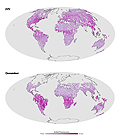NASA scientists have for the first time used satellite imagery to produce a global map of how land plants fluoresce, a breakthrough that should enable researchers to more quickly identify when vegetation is stressed and to better track the carbon cycle in terrestrial ecosystems. When land plants undergo photosynthesis, they emit a difficult-to-detect reddish glow that produces fluorescence. Using data collected in 2009 aboard a Japanese GOSAT satellite, NASA scientists were able to produce the fluorescence map by analyzing an unusually dark section of the infrared portion of the solar spectrum that indicates fluorescence. To date, scientists have used satellites to track plant and forest health primarily by examining imagery that indicates the “greenness” of a landscape. But NASA scientists said the new technology will enable them to produce a more detailed picture of plant health, and the fluorescence imagery will indicate that plants are under stress weeks before they begin turning yellow or brown. Such technology could help farmers respond to extreme weather or make it easier for aid workers to detect and react to famines, NASA said.
Global Land Fluorescence Is Mapped For the First Time
More From E360
-
Cities
‘Sponge City’: How Copenhagen Is Adapting to a Wetter Future
-
INTERVIEW
On Controlling Fire, New Lessons from a Deep Indigenous Past
-
Solutions
Paying the People: Liberia’s Novel Plan to Save Its Forests
-
OPINION
Forest Service Plan Threatens the Heart of an Alaskan Wilderness
-
INTERVIEW
Pakistan’s Solar Revolution Is Bringing Power to the People
-
Food & Agriculture
In Uganda, Deadly Landslides Force an Agricultural Reckoning
-
Energy
Why U.S. Geothermal May Advance, Despite Political Headwinds
-
Food & Agriculture
In War Zones, a Race to Save Key Seeds Needed to Feed the World
-
Climate
Lightning Strikes the Arctic: What Will It Mean for the Far North?
-
RIVERS
A Win for Farmers and Tribes Brings New Hope to the Klamath
-
Solutions
Deconstructing Buildings: The Quest for New Life for Old Wood
-
NATURAL DEFENSES
How Restored Wetlands Can Protect Europe from Russian Invasion
